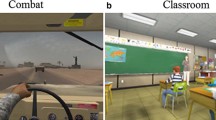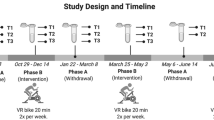Opinion Statement
Purpose In this article, we present data incorporating heart rate variability (HRV) into a graded virtual reality protocol performed in both a combat environment and an active control (classroom) environment, for combat Veterans with and without PTSD.
Recent Findings Exposure therapy for PTSD has proven effective. There is increasing interest in the use of virtual reality exposure therapy (VRET)-customized environments incorporating auditory, visual, and olfactory sensory modalities, to augment exposure-based treatment for PTSD. Particularly for combat Veterans, VRET may offer the advantage of a more realistic in vivo exposure for treatment. When combined with concurrent psychophysiological data, VRET has the potential to inform PTSD diagnosis, predict therapeutic responsiveness, and provide objective indicators of treatment response. HRV was not different between Veteran with and without PTSD, but our group recently found that Veterans with PTSD had differential skin conductance responses compared with Veterans without PTSD.
Summary Virtual reality is a promising treatment for PTSD. Methodological factors may have influenced the absence of significant findings in the current data. Future research which optimizes the potential use of psychophysiological assessments for the development of biomarkers and prediction of PTSD treatment response, or to inform the process of PTSD treatment, remain important.

Similar content being viewed by others
References and Recommended Reading
Recently published papers of particular interest have been highlighted as:• Of importance,•• Of major importance
Kessler RC, Berglund P, Demler O, Jin R, Merikangas KR, Walters EE. Lifetime prevalence and age-of-onset distributions of DSM-IV disorders in the National Comorbidity Survey Replication. Arch Gen Psychiatry. 2005;62(6):593–602.
Dohrenwend BP, Turner JB, Turse NA, Adams BG, Koenen KC, Marshall R. The psychological risks of Vietnam for U.S. veterans: a revisit with new data and methods. Science. 2006;313(5789):979–82.
Rothbaum BO, Hodges L, Alarcon R, Ready D, Shahar F, Graap K, et al. Virtual reality exposure therapy for PTSD Vietnam veterans: a case study. J Trauma Stress. 1999;12(2):263–71.
Rothbaum BO, Hodges LF, Ready D, Graap K, Alarcon RD. Virtual reality exposure therapy for Vietnam veterans with posttraumatic stress disorder. J Clin Psychiatry. 2001;62(8):617–22.
Rizzo A, Pair J, McNerney PJ, Eastlund E, Manson B, Gratch J, et al. Development of a VR therapy application for Iraq war military personnel with PTSD. Stud Health Technol Inform. 2005;111:407–13.
Botella C, Serrano B, Banos RM, Garcia-Palacios A. Virtual reality exposure-based therapy for the treatment of post-traumatic stress disorder: a review of its efficacy, the adequacy of the treatment protocol, and its acceptability. Neuropsychiatr Dis Treat. 2015;11:2533–45.
Goncalves R, Pedrozo AL, Coutinho ES, Figueira I, Ventura P. Efficacy of virtual reality exposure therapy in the treatment of PTSD: a systematic review. PLoS One. 2012;7(12):e48469.
McLay RN, Wood DP, Webb-Murphy JA, Spira JL, Wiederhold MD, Pyne JM, et al. A randomized, controlled trial of virtual reality-graded exposure therapy for post-traumatic stress disorder in active duty service members with combat-related post-traumatic stress disorder. Cyberpsychol Behav Soc Netw. 2011;14(4):223–9.
Miyahira SD, Folen RA, Hoffman HG, Garcia-Palacios A, Spira JL, Kawasaki M. The effectiveness of VR exposure therapy for PTSD in returning warfighters. Stud Health Technol Inform. 2012;181:128–32.
Reger GM, Holloway KM, Candy C, Rothbaum BO, Difede J, Rizzo AA, et al. Effectiveness of virtual reality exposure therapy for active duty soldiers in a military mental health clinic. J Trauma Stress. 2011;24(1):93–6.
Morina N, Ijntema H, Meyerbroker K, Emmelkamp PM. Can virtual reality exposure therapy gains be generalized to real-life? A meta-analysis of studies applying behavioral assessments. Behav Res Ther. 2015;74:18–24.
Kramer TL, Savary PE, Pyne JM, Kimbrell TA, Jegley SM. Veteran perceptions of virtual reality to assess and treat posttraumatic stress disorder. Cyberpsychol Behav Soc Netw. 2013;16(4):293–301.
Heart rate variability: standards of measurement, physiological interpretation and clinical use. Task Force of the European Society of Cardiology and the North American Society of Pacing and Electrophysiology. Circulation. 1996;93(5):1043–65. doi:10.1161/01.CIR.93.5.1043
Laborde S, Mosley E, Thayer JF. Heart rate variability and cardiac vagal tone in psychophysiological research—recommendations for experiment planning, data analysis, and data reporting. Front Psychol. 2017;8:213.
Bedi US, Arora R. Cardiovascular manifestations of posttraumatic stress disorder. J Natl Med Assoc. 2007;99(6):642–9.
Chalmers JA, Heathers JA, Abbott MJ, Kemp AH, Quintana DS. Worry is associated with robust reductions in heart rate variability: a transdiagnostic study of anxiety psychopathology. BMC Psychol. 2016;4(1):32.
Fisher AJ, Newman MG. Heart rate and autonomic response to stress after experimental induction of worry versus relaxation in healthy, high-worry, and generalized anxiety disorder individuals. Biol Psychol. 2013;93(1):65–74.
Liddell BJ, Kemp AH, Steel Z, Nickerson A, Bryant RA, Tam N, et al. Heart rate variability and the relationship between trauma exposure age, and psychopathology in a post-conflict setting. BMC Psychiatry. 2016;16:133.
Shah AJ, Lampert R, Goldberg J, Veledar E, Bremner JD, Vaccarino V. Posttraumatic stress disorder and impaired autonomic modulation in male twins. Biol Psychiatry. 2013;73(11):1103–10.
Hauschildt M, Peters MJ, Moritz S, Jelinek L. Heart rate variability in response to affective scenes in posttraumatic stress disorder. Biol Psychol. 2011;88(2–3):215–22.
Tan G, Dao TK, Farmer L, Sutherland RJ, Gevirtz R. Heart rate variability (HRV) and posttraumatic stress disorder (PTSD): a pilot study. Appl Psychophysiol Biofeedback. 2011;36(1):27–35.
• Minassian A, Maihofer AX, Baker DG, Nievergelt CM, Geyer MA, Risbrough VB, et al. Association of predeployment heart rate variability with risk of postdeployment posttraumatic stress disorder in active-duty marines. JAMA Psychiatry. 2015;72(10):979–86. This study established the association between heart rate variability and posttraumatic stress disorder. Their results suggest heart rate variability may have potential as a biomarker for identifying those at risk for development of postraumatic stress disorder after trauma exposure
Clausen AN, Aupperle RL, Sisante JF, Wilson DR, Billinger SA. Pilot investigation of PTSD, autonomic reactivity, and cardiovascular health in physically healthy combat veterans. PLoS One. 2016;11(9):e0162547.
•• van’t Wout M, Spofford CM, Unger WS, Sevin EB, Shea MT. Skin conductance reactivity to standardized virtual reality combat scenes in veterans with PTSD. Applied Psychophysiology and Biofeedback. 2017; doi:10.1007/s10484-017-9366-0. This study demonstrates differences in skin conductance responses to virtual reality combat exposure between groups of Veterans with and without posttraumatic stress disorder. These results suggest skin conductance may be a viable biomarker for use during treatment, to discriminate between patient groups and substantiates posited differences in autonomic regulation between those with and without posttraumatic stress disorder
Cristea IA, Valenza G, Scilingo EP, Szentagotai Tatar A, Gentili C, David D. Autonomic effects of cognitive reappraisal and acceptance in social anxiety: evidence for common and distinct pathways for parasympathetic reactivity. J Anxiety Disord. 2014;28(8):795–803.
Jonsson P, Wallergard M, Osterberg K, Hansen AM, Johansson G, Karlson B. Cardiovascular and cortisol reactivity and habituation to a virtual reality version of the Trier Social Stress Test: a pilot study. Psychoneuroendocrinology. 2010;35(9):1397–403.
Blake DD, Weathers FW, Nagy LM, Kaloupek DG, Gusman FD, Charney DS, et al. The development of a clinician-administered PTSD scale. J Trauma Stress. 1995;8(1):75–90.
Spitzer RL, Williams JB, Gibbon M, First MB. The structured clinical interview for DSM-III-R (SCID). I: history, rationale, and description. Arch Gen Psychiatry. 1992;49(8):624–9.
Wilhelm FH, Pfaltz MC, Gross JJ, Mauss IB, Kim SI, Wiederhold BK. Mechanisms of virtual reality exposure therapy: the role of the behavioral activation and behavioral inhibition systems. Appl Psychophysiol Biofeedback. 2005;30(3):271–84.
• Costanzo ME, Leaman S, Jovanovic T, Norrholm SD, Rizzo AA, Taylor P, et al. Psychophysiological response to virtual reality and subthreshold posttraumatic stress disorder symptoms in recently deployed military. Psychosom Med. 2014;76(9):670–7. This paper demonstrates a link between sub-clinical posttraumatic stress disorder and psychophysiologic responses to a virtual reality combat environment.
Author information
Authors and Affiliations
Corresponding author
Ethics declarations
Conflict of Interest
Dr. Carpenter reports personal fees from the Brown Department of Psychiatry and Human Behavior, during the conduct of the study.
Dr. Philip reports grants from the US Dept. of Veterans Affairs, during the conduct of the study.
Samuel J. Ridout declares that he has no conflict of interest.
Christopher M. Spofford declares that he has no conflict of interest.
Mascha van’t Wout-Frank declares that she has no conflict of interest.
William S. Unger declares that he has no conflict of interest.
Audrey R. Tyrka declares that she has no conflict of interest.
Tracie Shea reports grants from the US Dept. of Veterans Affairs, during the conduct of the study.
Human and Animal Rights and Informed Consent
This article does not contain any studies with human or animal subjects performed by any of the authors.
Funding/Disclosures
This work was supported by U.S. Department of Defense W81XWH-07-1-0689, R25 MH101076 (SJR) and IK2 CX000724 (NSP). The views expressed in this article are those of the authors and do not necessarily reflect the position or policy of the Department of Veterans Affairs or National Institutes of Health. The authors report no relevant conflicts of interest.
Additional information
This article is part of the Topical Collection on Post-Traumatic Stress Disorders
Rights and permissions
About this article
Cite this article
Ridout, S.J., Spofford, C.M., van’t Wout-Frank, M. et al. Heart Rate Variability Responses to a Standardized Virtual Reality Exposure in Veterans with PTSD. Curr Treat Options Psych 4, 271–280 (2017). https://doi.org/10.1007/s40501-017-0118-9
Published:
Issue Date:
DOI: https://doi.org/10.1007/s40501-017-0118-9




